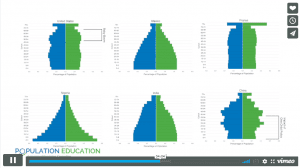In 2022, Statistics Korea reported that South Korea had broken its own record for the lowest fertility rate in the world. Estimates are currently at 0.81 children per woman, compared to 1.6 in the U.S. and as high as 6.8 in Niger. Globally, the average is 2.4 children per woman.
This means that South Korea’s population is expected to decline rather sharply in the coming decades. A fertility rate of 2.1 children per woman is replacement-level fertility and would create little change in population over time. A fertility rate of 0.81 is significantly below replacement level. This contributes to the UN’s projection that by 2100, South Korea’s population will be what it was around 1960.
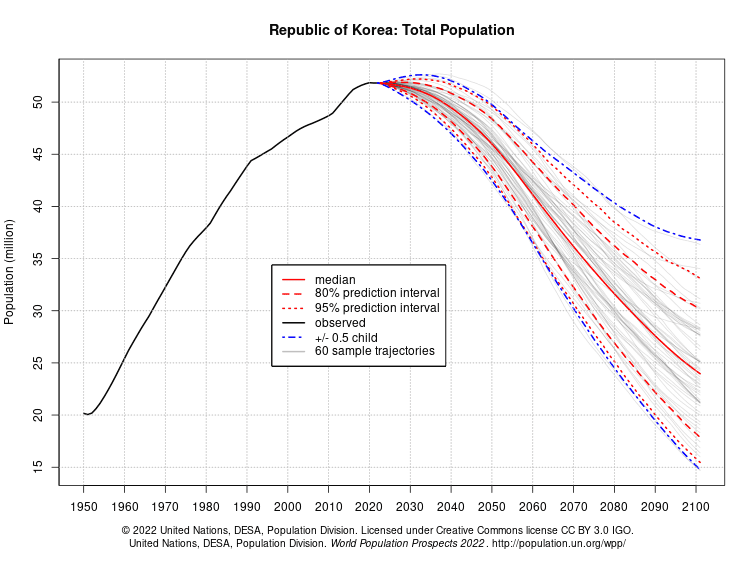
What’s leading to this decline in South Korea’s fertility rate and population? It’s complex, of course, and nearly impossible to make direct causal inferences. Nevertheless, it can be fruitful to examine how the country’s specific history and culture may have contributed to this present-day reality.
Setting the Stage: The Korean War, 1950-53
Officially known as the Republic of Korea, South Korea was founded in 1948 during the early stages of the Cold War. (Yes, it’s only 75 years old!) The Korean Peninsula was split in two, with North Korea becoming a communist state under Soviet supervision and South Korea becoming a capitalist one under the U.S. Each claimed to be the sole legitimate government of the entire peninsula, and an extremely destructive war ensued between North and South. (We should note that the “Cold” War really wasn’t so cold in most of the world; it involved many hot wars and much bloodshed.)
Nearly 5 million people died in the Korean War. Over half of those deaths were civilian casualties, destroying about 10% of Korea’s prewar population. Those who survived also suffered from extreme poverty, malnutrition, and starvation, not to mention trauma. In the 1950s and 60s, per capita income in South Korea was less than $100 – about the same as in the poorest countries in the world today.
South Korea’s Post-War Economic Recovery
In order to recover from extreme poverty and instability post-war, a series of authoritarian governments backed by the U.S. took hold in South Korea, focusing on rapid capitalist economic development. Though methods were controversial – involving dictatorship, censorship, violent suppression of protest, and other civil and human rights violations – South Korea undoubtedly did recover economically. In fact, it thrived. In a matter of decades, South Korea transformed from a least developed country to a highly developed one, astonishing politicians and economists across the world. The phenomenon came to be known as the “Miracle on the Han River.” The legacy of rapid growth continues today, evidenced through South Korea’s booming information technology industry and the “Korean Wave” of pop culture sweeping the globe.
Economic flourishing, food security, and the end of direct North-South combat allowed the population to swell. Importantly, population growth in South Korea was driven primarily by a dramatic decrease in deaths, not an increase in births. This can be seen in the graph below portraying Annual number of deaths.
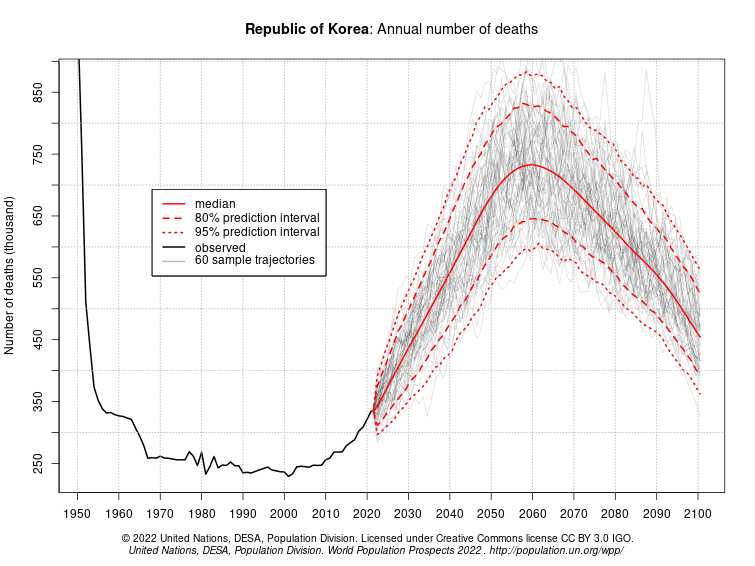
Economic Growth Fuels Competition in Korea
Seoul, South Korea’s capital city, was largely responsible for the country’s economic boom. Lower-income rural inhabitants seeking greater opportunity migrated in large numbers to the city – a phenomenon that still hasn’t let up.
As South Korea’s economy continued to grow, spurred by innovation and capitalistic ideals instated by the U.S., so did competition. Seoul is not a large city by area, yet its metropolitan area is home to nearly 30% of South Koreans. In 2021, Seoul’s population density was as great as 15,700 people per square kilometer, meaning that finding work and housing has become extremely difficult.
Korea had already had a long tradition of valuing education, but schooling became even more important as competition for jobs soared through the latter half of the 20th century and beyond. The Asian Financial Crisis of 1997-98 further exacerbated job insecurity, especially for young people. Together, the increase in time and money spent pursuing education and the lack of reliable job prospects have made it very challenging for young people to afford stable housing independent of their parents. Without space and sufficient savings of their own, many are struggling to begin families.
Furthermore, barriers to women’s education and work have begun coming down in the last decades, adding more women to the workplace. However, working women continue to face discrimination; for example, women are still expected to carry a disproportionate burden of domestic labor in double-income households, and some employers deliberately avoid hiring women who plan to get married and have children. Such pressures have led some women to prioritize salaried work at the expense of having children or being more engaged in family life.
These educational, occupational, and economic concerns have contributed to a sharp decline in births in South Korea, shown in the graph of Annual number of births below.
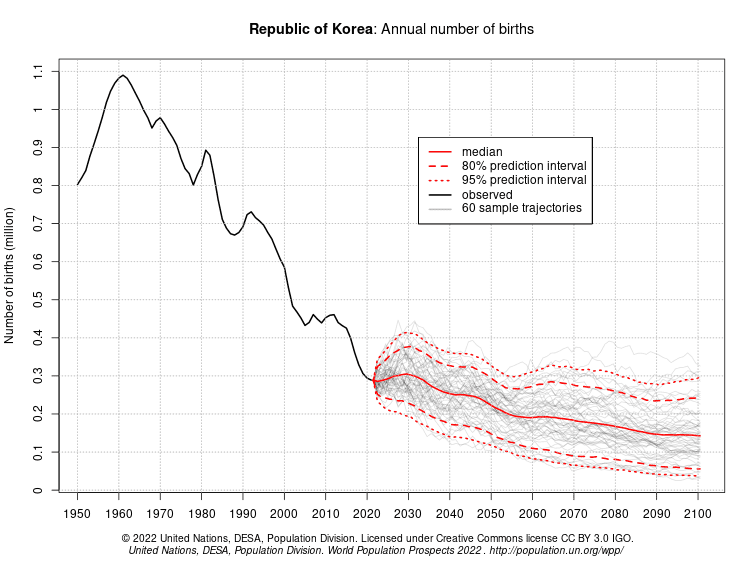
Korea Struggles to Welcome Immigrants
Typically, countries with low fertility rates can rely on immigration to stabilize population. However, South Korea does not have a strong history of in-migration, likely intensifying projections of population decline.
While under Japanese colonial rule (1910-1945), Koreans faced the constant threat of losing their cultural identity. Under a Japanese assimilationist policy, Koreans were required to adopt and exclusively use Japanese names, language, religion, and other traditions. In resistance, Koreans united to assert their belonging to a Korean nation. They blended ideas of blood, ancestry, and culture to set Korea apart from Japan. Ethnic homogeneity and pride had existed in smaller doses throughout Korean history, but it became extremely important in unifying and inspiring Koreans through the turbulence of the 20th century, which included colonialism, division, war, and dictatorships. Due to the strength of Korean ethnic nationalism, South Korea remains ethnically homogenous – over 99% of South Koreans are ethnically Korean – and struggles to welcome immigrants. The growing competition for jobs and resources also influence Korean perceptions of foreign immigration.
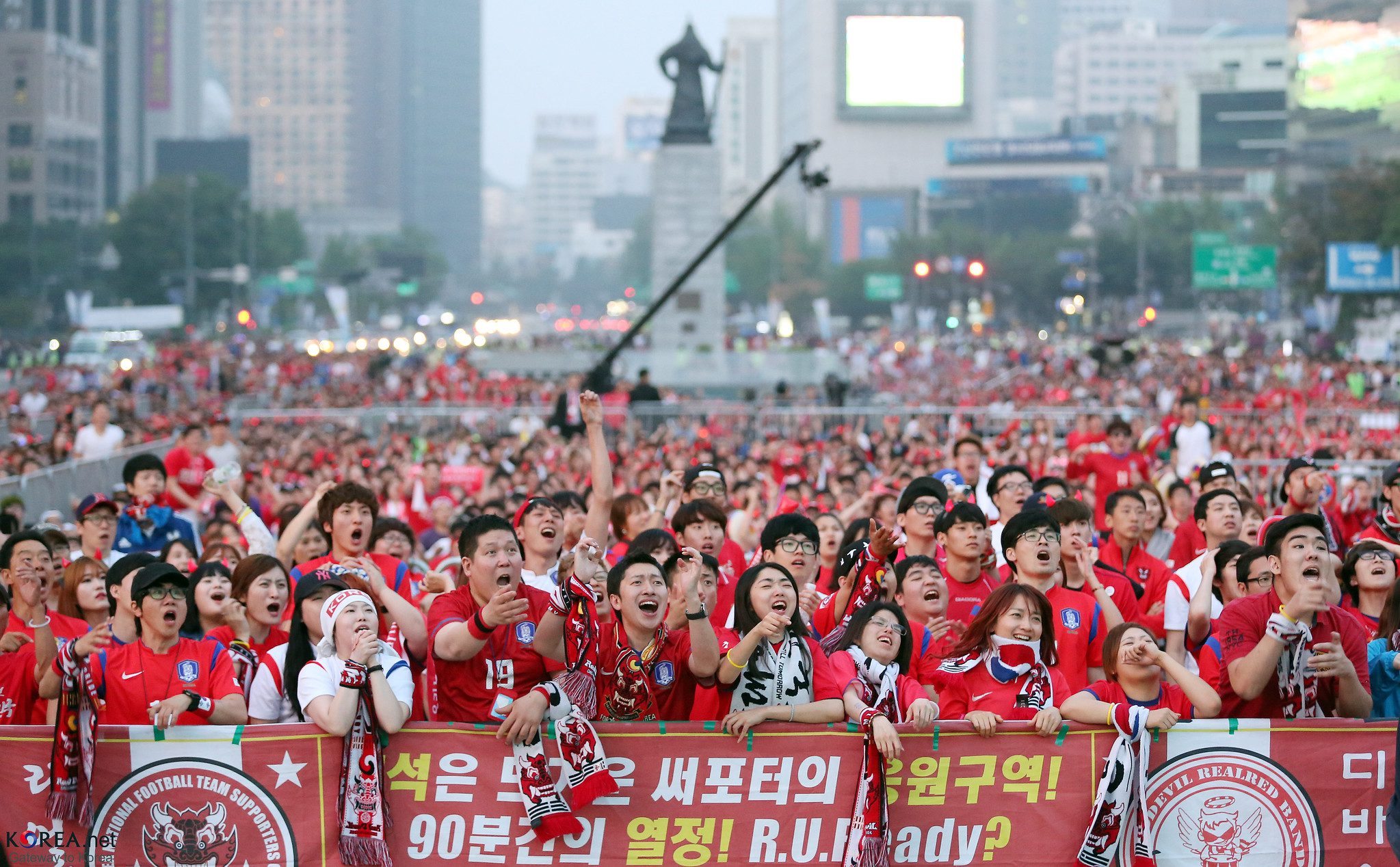
South Korean soccer fans gather in Seoul to cheer on their national team.
However, South Korea has begun making plans for a more immigration-friendly system to curb impending issues relating to population decline. The country’s widening global cultural influence has also been attracting foreign tourists and expats in recent years.
South Korea’s Shrinking Population
While the world as a whole struggles with population growth, some countries, like South Korea, grapple with the opposite. As nations address both concerns in the coming decades, nearly all will need to adapt to changing demographics, cultures, and values.
Image credits: Population projection (Republic of Korea: Total Population by the United Nations, DESA, Population Division); Mortality projection (Republic of Korea: Annual number of deaths by the United Nations, DESA, Population Division); Fertility projection (Republic of Korea: Annual number of births by the United Nations, DESA, Population Division); Korean soccer fans (Korea_Fans_Cheers_Team_Korea_20140627_04 by Republic of Korea is licensed under CC BY-SA 2.0)



